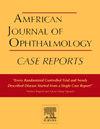Implantation of a scleral fixated (Carlevale) EDOF IOL in aphakia
Q3 Medicine
引用次数: 0
Abstract
Purpose
To present a case of lens dislocation in which an Extended Depth of Focus (EDOF) scleral fixated (Carlevale) intraocular lens (IOL) was inserted after performing pars plana vitrectomy (PPV) and lens fragmentation.
Case report
A 68-year-old woman presented to our department with loss of vision in her right eye after a blunt trauma in the right eye. After clinical examination the patient was aphakic with a dropped nucleus in the vitreous cavity. Surgical plan involved PPV with lens fragmentation and insertion of an IOL. Due to patient circumstances, she requested spectacle independence as far as possible. In order to support her needs a custom made Carlevale EDOF scleral fixated IOL (FIL SSF EVOLVE) was successfully implanted in her right eye with excellent post operative results. Excellent distant visual acuity as well as good intermediate and near vision was achieved 3 months post-operative in our patient.
Conclusion
According to previous reports as well as from our own previous experience, achieving efficient scleral fixation using the Carlevale FIL SSF IOL seems like a promising option in cases of aphakia or zonular dehiscence. EDOF lens technology is widely used in routine cataract surgery for demanding patients who require a wider range of vision without glasses. Combining these two technologies lead to a lens design (Carlevale FIL SSF EVOLVE) that we used in this case and enabled us to help our patient and improve her quality of life.
无晶状体巩膜固定(Carlevale) EDOF人工晶体植入术
目的报道一例玻璃体切除术(PPV)术后晶状体碎裂植入扩展焦深(EDOF)巩膜固定(Carlevale)人工晶状体脱位的病例。病例报告一名68岁女性因右眼钝性创伤后视力丧失而来我科就诊。经临床检查,患者为无晶状体,玻璃体腔内核下垂。手术计划包括PPV合并晶状体碎裂和人工晶体植入术。由于患者的情况,她要求尽可能独立使用眼镜。为了满足患者的需要,我们成功地在其右眼植入了一颗定制的Carlevale EDOF巩膜固定人工晶体(FIL SSF EVOLVE),术后效果良好。术后3个月远视力良好,中、近视力良好。结论根据以往的报道和我们自己以往的经验,使用Carlevale FIL SSF人工晶状体实现有效的巩膜固定似乎是无晶状体或带状裂孔病例的一个很有希望的选择。EDOF晶状体技术被广泛应用于常规白内障手术中,用于那些不戴眼镜需要更大范围视力的患者。结合这两种技术,我们在这个病例中使用了一种镜片设计(Carlevale FIL SSF EVOLVE),使我们能够帮助我们的病人并提高她的生活质量。
本文章由计算机程序翻译,如有差异,请以英文原文为准。
求助全文
约1分钟内获得全文
求助全文
来源期刊

American Journal of Ophthalmology Case Reports
Medicine-Ophthalmology
CiteScore
2.40
自引率
0.00%
发文量
513
审稿时长
16 weeks
期刊介绍:
The American Journal of Ophthalmology Case Reports is a peer-reviewed, scientific publication that welcomes the submission of original, previously unpublished case report manuscripts directed to ophthalmologists and visual science specialists. The cases shall be challenging and stimulating but shall also be presented in an educational format to engage the readers as if they are working alongside with the caring clinician scientists to manage the patients. Submissions shall be clear, concise, and well-documented reports. Brief reports and case series submissions on specific themes are also very welcome.
 求助内容:
求助内容: 应助结果提醒方式:
应助结果提醒方式:


